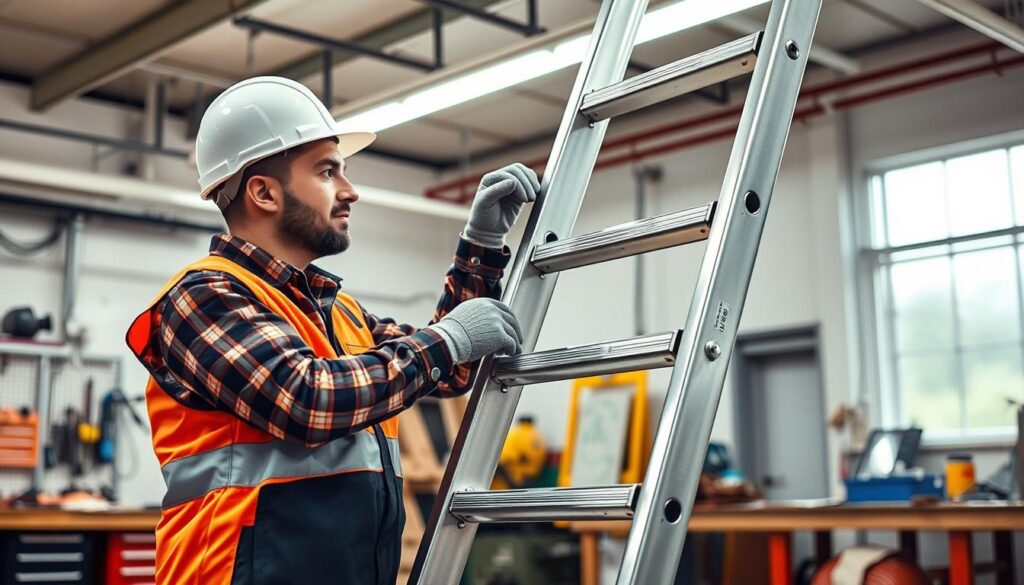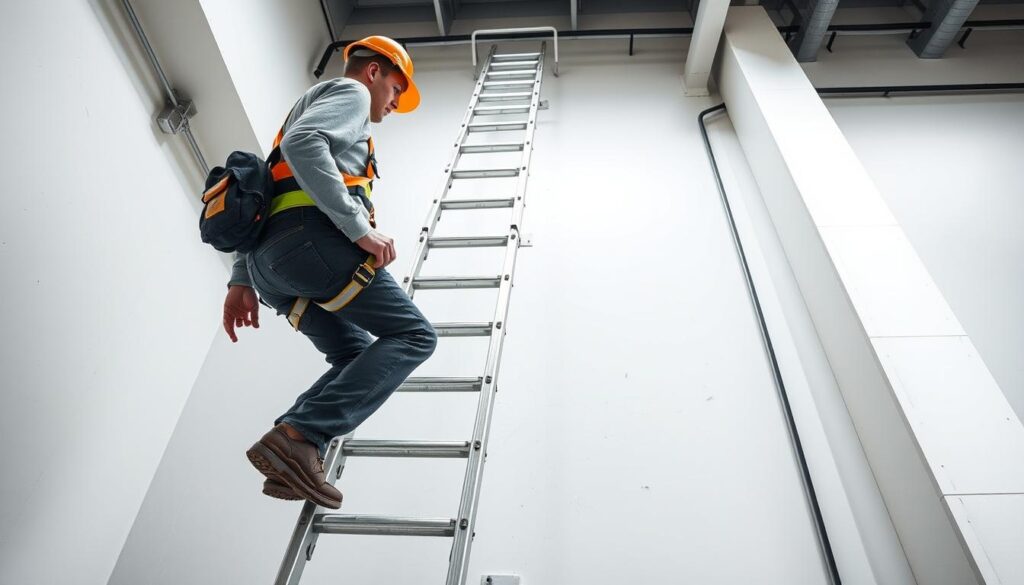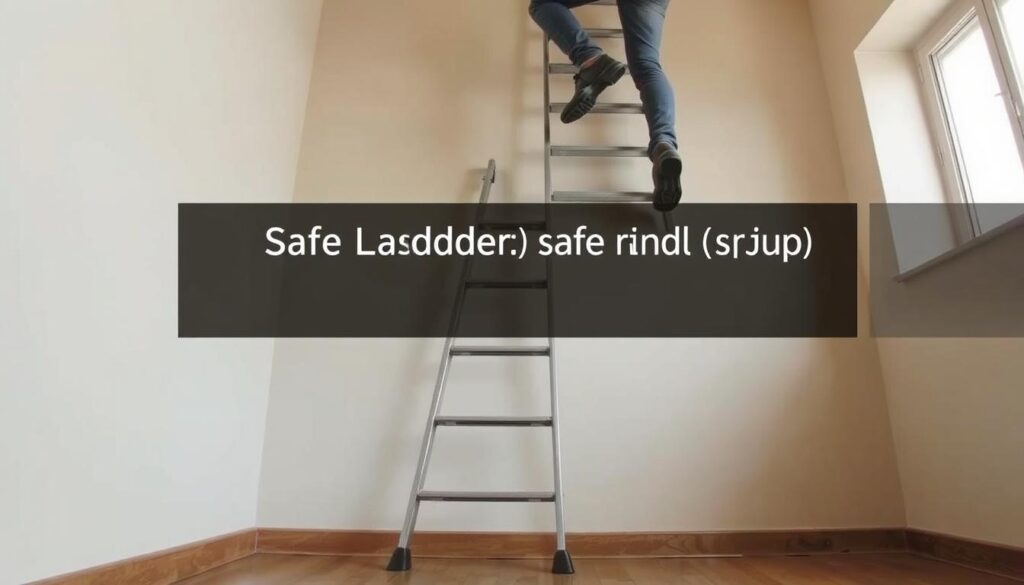Are you aware of the risks associated with using a ladder at height? Every year, numerous accidents occur due to improper ladder setup, resulting in serious injuries and even fatalities.
Proper ladder safety is crucial for preventing such incidents, whether you’re a DIY enthusiast or a professional tradesperson working at height.
This comprehensive guide will walk you through the essential steps of choosing the right ladders for your task, setting them up correctly to minimise the risk of a fall, and using them efficiently to get your work done effectively.
Key Takeaways
- Understanding the importance of ladder safety in preventing accidents.
- Learning how to choose the appropriate ladders for different tasks.
- Gaining insights into proper ladder setup techniques.
- Discovering how to use ladders safely at height.
- Improving your work efficiency by following safety protocols.
Understanding Different Types of Ladders
When it comes to choosing the right ladder for your job, understanding the different types of ladders available is crucial. Ladders are not one-size-fits-all tools; they vary significantly in design, functionality, and application.
Stepladders vs. Extension Ladders
Stepladders are self-supporting ladders with flat steps, ideal for tasks that require a stable, elevated platform. Extension ladders, on the other hand, are designed to reach higher areas by extending to various heights. They require leaning against a stable surface for support.
Combination and Multi-purpose Ladders
Combination and multi-purpose ladders offer versatility, transforming into different configurations to suit various tasks. These ladders can function as stepladders, extension ladders, or even scaffold supports. Key features include hinged sections, locking mechanisms, and adjustable heights, making them adaptable to different jobs. It’s essential to follow the manufacturer’s instructions for each configuration to ensure safe usage.
Essential Pre-use Ladder Inspection
A pre-use ladder inspection is essential for ensuring your safety when working at heights. Before you climb, you must check your ladder for any signs of wear or damage.
Checking for Structural Damage
Inspect your ladder for cracks or splits in the rails or rungs, loose or missing hardware, and damaged or worn non-slip feet. Signs of corrosion or rust on metal ladders and wood rot or splitting in wooden ladders are also critical defects to identify. Regularly checking these areas can help prevent accidents.
Identifying Wear and Defects
Look for grease, dirt, or other contaminants on the steps or rungs that can cause slips or falls. Be aware of paint or stickers that might hide defects. Inspect critical wear points such as rung-to-rail connections and locking mechanisms on your ladders. Ensuring all components are functioning correctly is vital for safe ladder use.

- Regular inspections can identify common wear patterns and defects.
- Check for surface contaminants that can create slipping hazards.
- Inspect critical wear points like rung-to-rail connections.
Safe Ladder Setup and Usage Tips
Before climbing, ensure your ladder is set up on a stable surface. A firm and level ground is essential for stability. The surface should support the weight of the ladder and the person using it.
The 4-to-1 Rule for Proper Ladder Angle
To achieve the correct angle, follow the 4-to-1 rule: for every four feet of ladder height, move the base one foot away from the wall. This ensures safe use and prevents the ladder from becoming too steep or too shallow.
Ensuring Stability on Different Surfaces
Different surfaces require different setup techniques. For hard ground, rest the ladder feet flat on the surface, ensuring the area is free of slippery materials. For soft ground, flip the feet up and drive their spiked ends into the ground or use supplementary stabilising equipment like wide boards or anti-slip mats to create a level base.
Setting Up Ladders on Challenging Terrain
Setting up ladders on challenging terrain involves specific techniques to enhance stability and safety. When the ground is uneven or slippery, extra precautions are necessary to prevent accidents.
Techniques for Uneven Ground
On uneven ground, you can use various techniques to level your ladder. One method is to use a ladder leveler, which attaches to the ladder’s feet, allowing you to adjust to the terrain. For minor adjustments, placing sturdy objects like wooden blocks under the ladder’s legs can also help achieve a level position.
Using Ladder Levelers and Stabilisers
Ladder levelers and stabilizers are valuable equipment for enhancing safety. Levelers are adjustable feet that attach to the bottom of the ladder, compensating for uneven ground. They’re especially useful on slopes or stairs. Stabilizers, also known as standoffs, widen the ladder’s top contact points, providing extra stability when working around windows or on roofs.
| Terrain Challenge | Recommended Equipment | Benefits |
|---|---|---|
| Uneven Ground | Ladder Levelers | Adjusts to terrain, enhances stability |
| Slope or Stairs | Ladder Levelers | Compensates for incline, improves safety |
| Working around Windows or Roofs | Ladder Stabilizers (Standoffs) | Widen contact points, increases stability |
Maintaining Three Points of Contact
To minimize the risk of accidents, it’s essential to maintain three points of contact while on a ladder. This fundamental safety precaution significantly reduces the likelihood of slipping or falling.
Why Three Points of Contact Matters
Maintaining three points of contact, whether two hands and one foot or two feet and one hand, ensures stability on the ladder. This is crucial because it allows you to securely hold onto the ladder while climbing or working, thereby preventing accidents. Avoid holding items when climbing; instead, consider using a tool belt to keep your hands free.
Practical Tips for Maintaining Contact
To maintain three points of contact effectively, face the ladder when climbing up or down, and ensure your body is centred between the side rails. Use a tool belt or pouch to carry items, keeping your hands free to grip the ladder. When transitioning between climbing and working, minimize the time spent with fewer than three points of contact. Proper foot placement on rungs and hand positioning on rails is also vital for balance and stability.
Advanced Ladder Safety Techniques
Ladder safety goes beyond basic precautions; it involves adopting advanced techniques for secure usage. To minimise risk, you must consider various factors when setting up and using ladders.
Securing Ladders at the Top
When using ladders near the top, ensure they are properly secured. This can be achieved by tying the ladder to a stable structure or using ladder stabilisers. This precaution helps prevent the ladder from shifting or falling.
Safe Roof Access Methods
For safe roof access, make sure the ladder extends at least 1 metre or three rungs above the roof edge. This provides a secure handhold when transitioning to and from the roof.
Working Near Doors and High-Traffic Areas
When setting up a ladder in high-traffic areas, ensure nearby doors are locked or barricaded. Position the ladder away from walkways if possible, and use warning signs or barriers to alert others. Always remove tools and materials from the ladder when not in use.

Conclusion: Prioritising Ladder Safety at Home and Work
In conclusion, prioritising ladder safety is crucial for preventing injuries and accidents in various settings. By following this comprehensive guide, you can significantly enhance your understanding of how to set up and use ladders safely.
Key principles include selecting the right ladder for the task, conducting thorough pre-use inspections, and maintaining three points of contact. It’s also vital to position ladders on stable surfaces and be aware of your surroundings. For more detailed information, refer to the Safe Use of Ladders and Stepladders.
By adopting these practices, you can minimise risks associated with ladder use at home or at work. Share your knowledge with others to promote a culture of safety and reduce the prevalence of ladder-related accidents.



